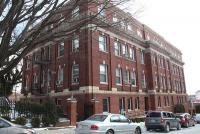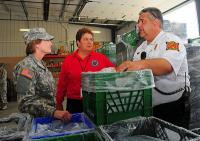-
Three new Engineering Research Centers to advance U.S. resiliency, sustainability

The NSF awards $55.5 million for compact mobile power, off-grid water treatment, and nature-inspired soil engineering. The NSF says that innovations that improve the affordability, availability, quality, and resilience of infrastructure services will enhance the nation’s economic competitiveness and societal well-being.
-
-
Tackling urban water crises

With drought conditions putting a strain on resources throughout South Florida, FIU researchers are investigating long-term solutions to water crises as part of a newly launched consortium. The Urban Water Innovation Network (UWIN) comprises fourteen academic institutions and key partners across the United States. The UWIN researchers hope to create technological, institutional, and management solutions that will help communities increase the resilience of their water systems and enhance preparedness for responding to water crises.
-
-
Building resilient urban infrastructure to cope with climate challenges
In addition to urban flooding, global climate change is predicted to bring increased coastal flooding, like that associated with Hurricane Katrina and Superstorm Sandy, as well as extreme heat. As extreme weather events like these occur more frequently, global climate change may demand that we recalibrate our definition of “rare.” Historically, infrastructure to mitigate flooding and extreme heat has been designed to be fail-safe, meaning that it is designed to be fail-proof. But recently we have seen that fail-safe can be a dangerous illusion. Fifty researchers from different disciplines from fifteen institutions have teamed up to explore these challenges and to change the way we think about urban infrastructure.
-
-
$4 million awarded to support earthquake early warning system in Pacific Northwest
The U.S. Geological Survey (USGS) last week has awarded approximately $4 million to four universities — California Institute of Technology, University of California, Berkeley, University of Washington, and University of Oregon — to support transitioning the ShakeAlert earthquake early warning (EEW) system toward a production stage. A functioning early warning system can give people a precious few seconds to stop what they are doing and take precautions before the severe shaking waves from an earthquake arrive.
-
-
Confronting weather extremes by making infrastructure more resilient
South Florida’s predisposition to weather extremes renders the region’s infrastructure acutely vulnerable. But weather extremes are not exclusive to South Florida. The Urban Resilience to Extreme Weather-Related Events Sustainability Research Network (UREx SRN), a newly formed team of researchers, is addressing these challenges on an international scale.
-
-
Coral reefs could protect Pacific islands from rising seas – but only if global warming slows
The coral reefs that have protected Pacific Islanders from storm waves for thousands of years could grow rapidly enough to keep up with escalating sea levels if ocean temperatures do not rise too quickly, according to a new study. If global temperatures continue to rise and thus retard the growth of these natural storm barriers, the homelands of millions of people on lands throughout the Pacific Ocean will be in jeopardy.
-
-
U.S. military bases vulnerable to cyberattacks on their power, utility systems
U.S. military bases are at risk for cyberattacks against the bases’ power grid and other utility systems, according to a new report on defense infrastructure from the Government Accounting Office. The 72-page GAO document concludes military bases “may be vulnerable to cyber incidents that could degrade operations and negatively impact missions.”
-
-
Different lessons from past floods
More and more frequent extreme weather events lead to new projects on risk management and spatial planning. Past experiences represent an added value and suggest the importance of greater involvement of local communities. Luckily, past mistakes can sometimes be useful for present or especially future decisions. This can apply to spatial planning and management in response to natural disasters and extreme weather events.
-
-
Israel bolsters cyber defenses to cope with an escalating number of cyberattacks
In 2013, Israel’s grid was cyberattacked, on average, a few hundred times per hour. Last year the average hourly attacks on Israel’s grid was 20,000.The number of detected cyberattacks on Israel reached two million a day during the war with Hamas last summer. The Israeli government decided there was a need to reorganize and improve the cyberdefense systems protecting Israel’s critical infrastructure.
-
-
Strengthening urban infrastructure to withstand extreme weather-related events
A multi-disciplinary team of about fifty researchers from fifteen universities and other institutions will address the vulnerability of urban infrastructure to extreme weather related events, and ways of reducing that vulnerability. Funded under a $12 million research grant from the National Science Foundation (NSF), the researchers will conduct their extensive work over the coming five years. In light of weather related extremes, such as increasing storm frequency and intensity, as well as climate uncertainties, this network will evaluate threats to transportation, electricity, water, and other services in major urban areas, and the social, ecological, and technical systems to protect infrastructure and increase its flexibility and adaptability, using new designs and technologies.
-
-
Washington, D.C. sinking fast, compounding threat of sea-level rise
New research confirms that the land under the Chesapeake Bay is sinking rapidly and projects that Washington, D.C., could drop by six or more inches by the end of this century — adding to the problems of sea-level rise. This falling land will exacerbate the flooding that the nation’s capital faces from rising ocean waters due to a warming climate and melting ice sheets — accelerating the threat to the region’s monuments, roads, wildlife refuges, and military installations. “It’s ironic that the nation’s capital — the place least responsive to the dangers of climate change — is sitting in one of the worst spots it could be in terms of this land subsidence,” says one researcher. “Will the Congress just sit there with their feet getting ever wetter?”
-
-
Safer structures to withstand earthquakes, windstorms
A new cyberinfrastructure effort funded by a $13.7 million grant from the National Science Foundation will help engineers build safer structures that can better withstand natural hazards such as earthquakes and windstorms. Researchers aim to build a software platform, data repository, and tools that will help the United States design more resilient buildings, levees, and other public infrastructure that could protect lives, property and communities.
-
-
Sea level rise, storm surges increasing risk of “compound flooding” for major U.S. cities
Scientists investigating the increasing risk of “compound flooding” for major U.S. cities have found that flooding risk is greatest for cities along the Atlantic and Gulf coasts when strong storm surge and high rainfall amounts occur together. While rising sea levels are the main driver for increasing flood risk, storm surges caused by weather patterns that favor high precipitation exacerbates flood potential.
-
-
Mangroves help protect coasts against sea level rise
Mangrove forests could play a crucial role in protecting coastal areas from sea level rise caused by climate change, according to new research. Taking New Zealand mangrove data as the basis of a new modelling system, the researchers were able to predict what will happen to different types of estuaries and river deltas when sea levels rise. They found areas without mangroves are likely to widen from erosion and more water will encroach inwards, whereas mangrove regions prevent this effect - which is likely due to soil building up around their mesh-like roots and acting to reduce energy from waves and tidal currents.
-
-
Fusion Centers important in promoting cybersecurity
Fusion centers were created after 9/11 to serve as primary focal points for state, local, federal, tribal, and territorial partners to receive, analyze, and share threat-related information. States can promote cybersecurity and enhance their capabilities by heightening the importance of cybersecurity as a mission of fusion centers, according to a paper released the other day by the National Governors Association (NGA).
-
- All
- Regional
- Water
- Biometrics
- Borders/Immig
- Business
- Cybersecurity
- Detection
- Disasters
- Government
- Infrastructure
- International
- Public health
- Public Safety
- Communication interoperabillity
- Emergency services
- Emergency medical services
- Fire
- First response
- IEDs
- Law Enforcement
- Law Enforcement Technology
- Military technology
- Nonlethal weapons
- Nuclear weapons
- Personal protection equipment
- Police
- Notification /alert systems
- Situational awareness
- Weapons systems
- Sci-Tech
- Sector Reports
- Surveillance
- Transportation
Advertising & Marketing: advertise@newswirepubs.com
Editorial: editor@newswirepubs.com
General: info@newswirepubs.com
2010-2011 © News Wire Publications, LLC News Wire Publications, LLC
220 Old Country Road | Suite 200 | Mineola | New York | 11501
Permissions and Policies
Editorial: editor@newswirepubs.com
General: info@newswirepubs.com
2010-2011 © News Wire Publications, LLC News Wire Publications, LLC
220 Old Country Road | Suite 200 | Mineola | New York | 11501
Permissions and Policies
